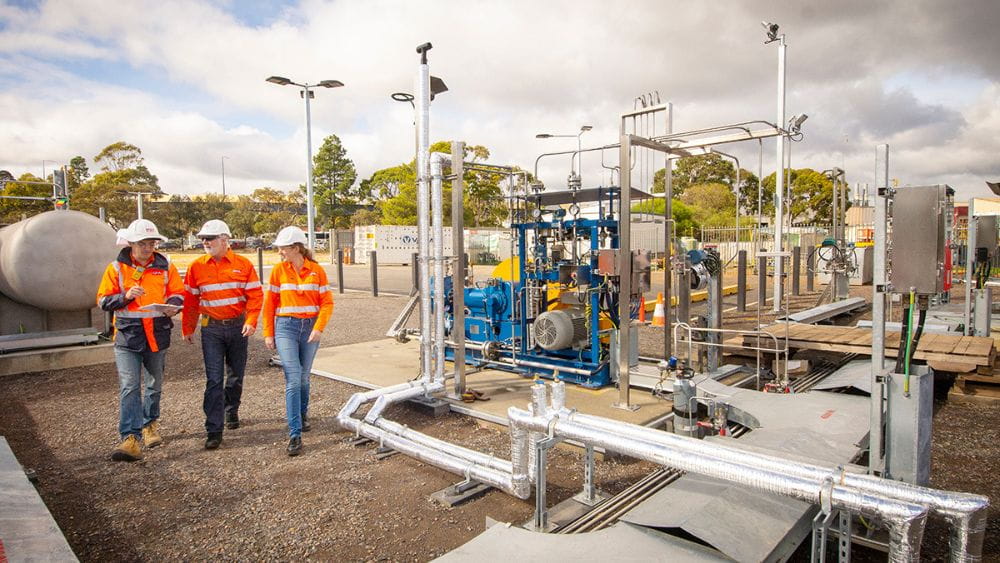
Journey to renewable gas with max
Kia ora, my name is Max Bowron, and I recently started my first professional job as Gas Network Performance Engineer at Powerco (Powerco is the parent company of The Gas Hub and owns the distribution network) in Wellington, after interning with the company during uni. I graduated from the University of Canterbury last year with a Bachelor of Mechanical Engineering and have really enjoyed learning about the gas industry and the challenges we face to decarbonise.
I was lucky enough to receive a scholarship from the Kennedy Educational Scholarship Trust (KEST) and GasNZ allowing me to attend the Australian Renewable Gas tour in April 2023. During the trip, I, along with 26 others, including two others from Powerco, will tour seven renewable gas sites across five Australian states, hosted by Bioenergy Australia. Our mates across the ditch are significantly further along the renewable gas pipeline than us, so this trip will serve as an awesome learning experience for the other tour delegates and myself to learn about the technology, strategies and policies used in successful initiatives in Australia. We will visit some exciting and innovative sites such as a green hydrogen generation plant and wastewater treatment plants which generate renewable energy with biogas collected from the breakdown of organic matter. Tune in this week as I share my trip and discuss what types of new innovative technologies Australia is implementing, and how the experience is for a young engineer in the gas industry. Find out more about the tour from GasNZ.
Photo credit: Photo above from GPA.
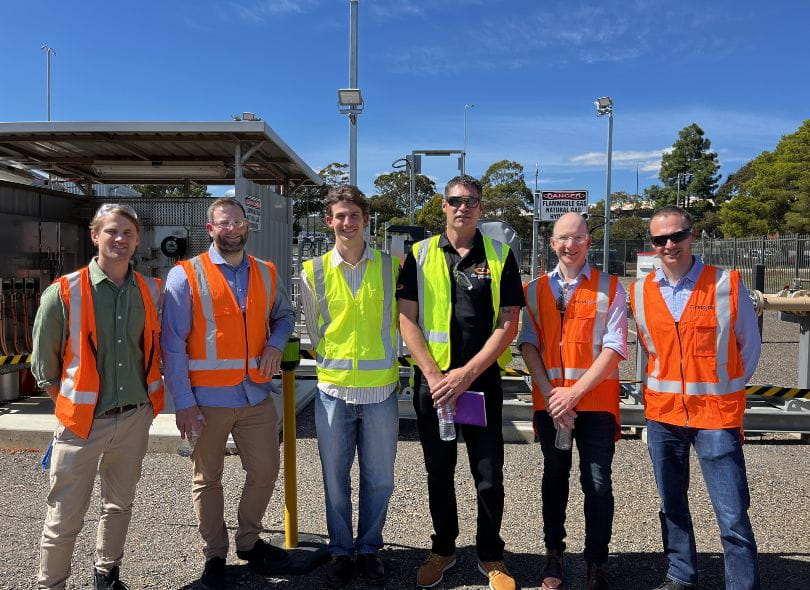
Max, third from left with Don Elers (Powerco's GM Gas) along with other tour group members.
Day one | South Australia
Our first day of the trip involved visiting two renewable gas generation plants in Adelaide, South Australia. The first of which was the Southern Region Waste Resource Authority (SRWRA), a landfill gas and biomethane plant run by LMS Energy. Over time waste breaks down releasing methane which is 28 times more harmful to the atmosphere than carbon dioxide. The SRWRA plant is built on top of an old landfill and captures the landfill methane to burn in its large biogas engines to generate electricity and sell back to the grid. The plant also utilises the organic waste coming in from the surrounding suburbs to generate biogas through use of anaerobic digestors which use controlled bacteria to digest the waste and produce biogas. Any electricity needed to run these plants is provided by the solar farm on site, making the entire process completely carbon neutral. SRWRA is a great example of waste-to-energy technology in action, and it was inspiring to learn about and think about how it could be implemented in New Zealand in future. Australia is more focused on electrifying, so they burn the generated biogas, but there is potential for us here in New Zealand to distribute this gas through our existing network, something that Powerco is looking at doing.
The second site we visited was Hydrogen Park South Australia (HyP SA), an Australian first that delivers renewable hydrogen to 3,700 nearby homes through the existing distribution network. Hydrogen is generated through an electrolyser which separates hydrogen and oxygen from water and is powered by renewable wind and solar generation nearby. The hydrogen is blended to 5% with natural gas and is reinjected back into the network. The site isn’t running at full capacity, as its purpose is more to show groups like ours about the technology and how it can be implemented elsewhere. For lunch we went to La Loft, a restaurant down the road which uses the hydrogen generated at the park to cook its delicious food. Later we fly to Melbourne, the second state out of our five this trip.
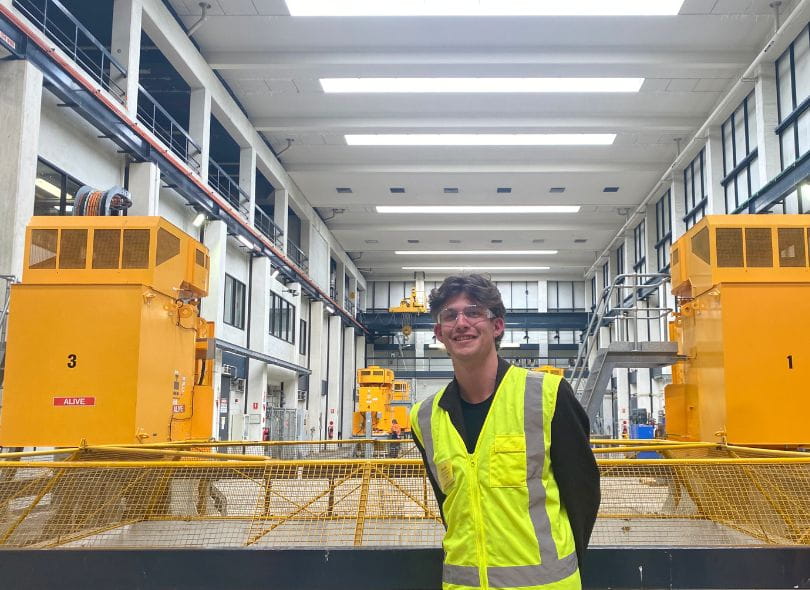
Max at Melbourne Water, wastewater treatment plant in Victoria.
Day two | Victoria
Our second day involved viewing two waste treatment plants across Melbourne. The first of which was Yarra Valley Water Rewaste, a plant in east Melbourne which takes in 140 tonnes of food and liquid waste every day to generate biogas through anaerobic digestors – this is then burnt to generate electricity to sell back to the grid. Customers pay to dump their organic waste at the plant, which is blended up into a slurry and pumped into two huge, pressurised tanks and is digested by the bacteria, creating two products in biogas and organic digestant. Unfortunately, the waste must be dumped due to Victorian policy, but there is progress on changing this legislation and allowing it to be re-purposed for agricultural use. There’s huge potential for similar plants in New Zealand, everybody has rubbish, right? With better waste management and separation infrastructure, plants such as the one in the Yarra Valley could be implemented across small towns and large cities in New Zealand, and with an implemented biogas to biomethane process, could be a solution to renewable gas across our country.
The second plant we visited was Melbourne Water, a wastewater treatment plant also in the east. The plant processes water from around 40% of Melbourne, equivalent to roughly half of New Zealand’s population! The water comes in large pipes and has three separate processes to return the water to grade class A, not quite drinking water but can be used for agriculture and amenities such as toilets. The solids separated from the wastewater is then pumped into one of eight large anaerobic digestion tanks to collect the biogas. They have the capacity to generate 600TJ of energy from biogas, roughly 8% of all residential gas use in New Zealand and it is then burnt in one of 7 V20 generators. The scale of this plant was quite mind-boggling, the land area taken up and energy generated blew my mind. Although it was larger than anything we would be able to produce in New Zealand, it was inspiring to see how scalable bioenergy is and to see the large potential for this technology worldwide.
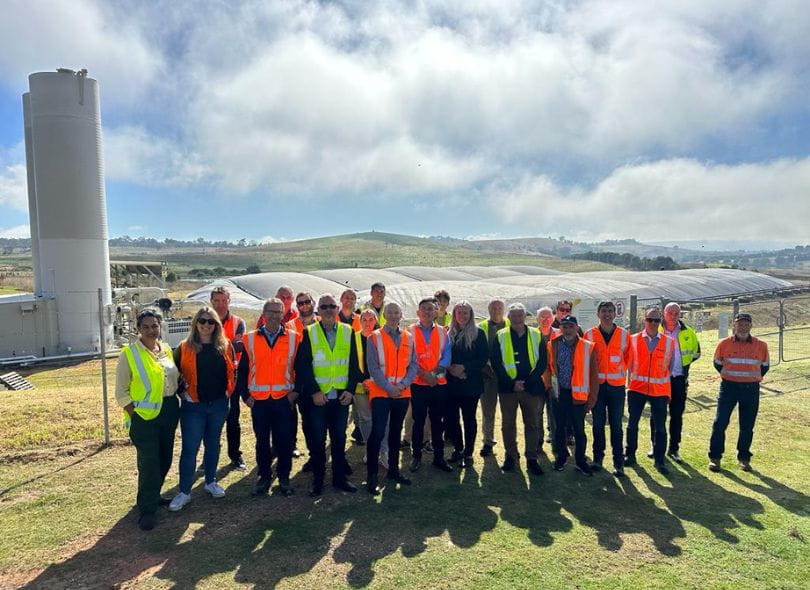
Max with the rest of the delegation at the Goulburn Bioenergy Project, New South Wales.
Day three | New South Wales
Our third day of the tour involved visiting two commercial companies in New South Wales that have introduced bioenergy into their everyday processes. It was great to see companies being able to continue to manufacture their produce while converting to green energy!
The first plant we visited was the Goulburn Bioenergy Project, operating at Southern Meats. The project collects wastewater from the processing of 4.5 – 6 thousand sheep and pumps it into an inflatable anaerobic digestor in one of their paddocks. The inflatable digestor is significantly more cost effective than the large-scale tanks we saw at previous sites, but still produces enough biogas to generate electricity for 70% of the plant’s needs. The other 30% is from natural gas. The photo also shows the scrubbing tower, which cleans the biogas of particulates so that it can be burned in its boiler for heat or in one of its two 800kW engines for electricity. The water in the digestor is then further cleaned and used for irrigation on the large sheep farms nearby. See the photo of the whole delegation in front of the digestor.
The second plant we visited was Australia’s largest canola oil producer, MSM Milling. Australia is the second largest canola oil producer in the world and MSM Milling produces 70% of the country’s oil. MSM use 100 tonnes of woodchips from nearby farms to fuel their huge 5 MW boiler, which produces half of the energy used in their ginormous plant. With the generated green energy, they process and squeeze the oil out of the canola grains, which they export from the train station on site. They even provide the oil for all of Australia’s KFC’s! They have a bottling production line on site too, which they achieve with the help of some robots.
Companies can fund these ventures with incentives from the government such as the LGC certificate. This scheme provides the company with a certificate for every MWh of renewable energy produced, which can then be sold to other businesses wanting to reduce their carbon emissions, essentially a carbon trading scheme. Incentives like this help motivate private companies to go green, and could be something to consider in order to build momentum for the bioenergy movement in New Zealand.
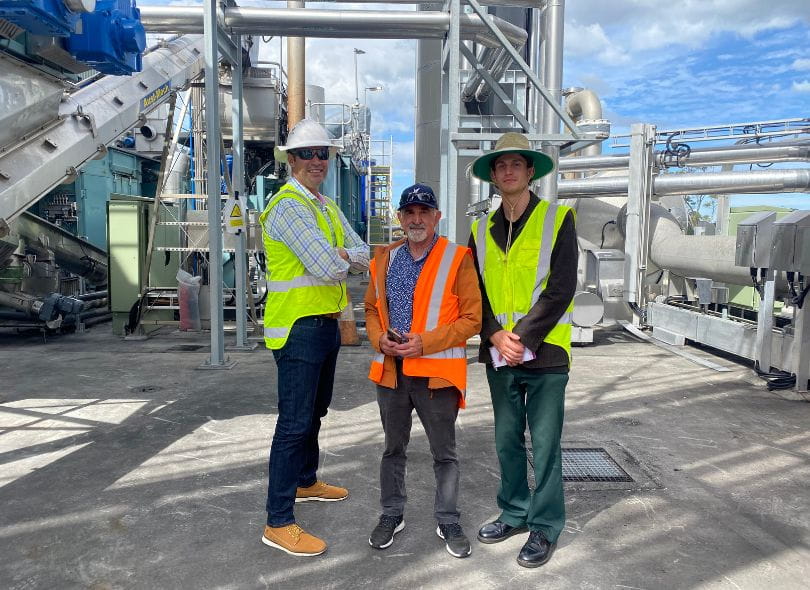
Don Elers, GM of Gas; Bruce Monk, Principal Engineer Gas and Max Bowron Gas Network Performance Engineer from Powerco at the Logan City Biosolids Gasification Project in Queensland.
Day four | Queensland
The final day of the tour finished up in Brisbane, and we viewed two projects before having a farewell dinner in the city. We visited the Logan City Biosolids Gasification Project and the Plumbing Industry Climate Action Centre, two very different projects to others we’ve visited.
The Logan City Biosolids Gasification Project is a wastewater treatment plant, that offsets 6,000 tonnes of carbon every year with its gasification process. The organic waste is separated from the water with a centrifuge and 90% of the water is removed from the solids through a drying process. The solids are then ignited in a large hearth, the excess heat from which is used to dry the new solids coming in. This makes the process renewable, and an onsite 1.1 MW solar farm generates electricity to run the plant. This by-product of the burnt solids is called biochar and is used in the agriculture industry as a fertiliser, making the whole process very environmentally friendly. It showed me how much potential waste-to-energy projects have in New Zealand and how our so-called waste can benefit other industries.
The final project we visited was the Plumbing Industry Climate Action Centre. It opened last year and is a huge facility used to teach and certify plumbing apprentices. What makes this site valuable to the tour was that they teach students how to do the piping and connections for hydrogen. Hydrogen molecules (H2) are much smaller than methane-natural gas molecules (CH4) meaning different fittings and procedures must be used and taught. It’s all well and good to be generating these green gases, but if our workforce doesn’t have the skills to fit out a house with hydrogen appliances, what’s the point? Personally, I hadn’t thought about this part of the biogas picture and this site opened my eyes to how much further we must go before we can become carbon-zero by 2050.
Ready to connect?
Check out the connection process, to know what choices you'll need to make as part of getting connected to natural gas.
Submit your natural gas connection application today. Our customer team will then ring you to confirm a few more details and progress your application.
Want to know more?
If you've had a good look around our website and still have questions let us know what you'd like more information about.
